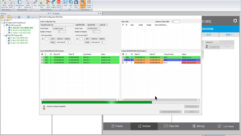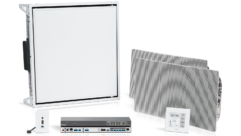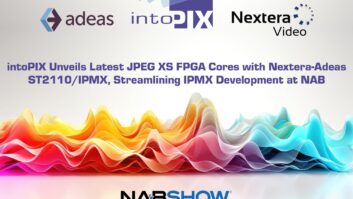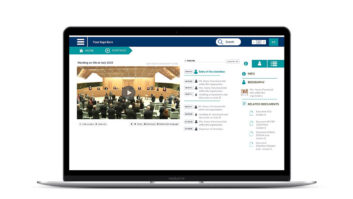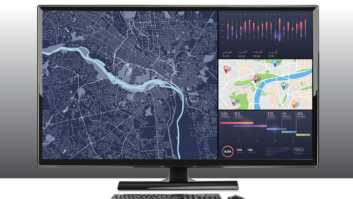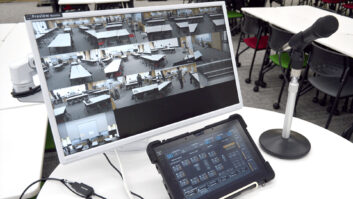
AV System Launches BurnLounge
A digital audio download service uses AV to stage a corporate event featuring live performances and a talk show-style venue on a single stage.
Two 6-foot-wide by 12-foot-long ScreenWorks projection screens fed by Christie Digital 5+16k projectors displayed the onstage activities at the BurnLounge corporate launch event at Bally’s Event Center in Las Vegas. The live content was captured using a Panasonic AJ-5DX900 DVCPRO 50 video camera.Dual-purpose audio
CHALLENGE: Add onstage video projection, and overcome low-ceilings, a lack of rigging points, and sound system requirements to achieve high-quality sound.
SOLUTION: Use two large video screens for projection, and add delay rigs and line arrays to create concert-quality sound.
FOR ITS THREE-DAY-LONG June 2006 kick-off event at Bally’s Event Center in Las Vegas, BurnLounge, a New York-based digital audio download service, wanted to create an environment where concert-quality, live performances and a corporate presentations could coexist on a single stage.
Organizers from BurnLounge turned to Dylan Marer, executive producer at Long Beach, CA-based Ascendant Marketing and Media, to produce the event, and manage its publicity and registration. Marer came up with a concept and sub-contracted frequent collaborator Stan Nickens, executive producer of Stanco Productions, a St. Louis-based AV and lighting staging company, to execute staging the AV system.
The plan called for two audio systems that would share a few components. The “concert” system was designed to recreate a live performance environment, while the “corporate” presentation system was constructed to ensure speech intelligibility.
Marer also wanted to add a video screen at the back of the stage to magnify interviews and performances for audience members seated near the back of the 300-foot-long room. Both systems also needed to be production quality because BurnLounge wanted the ability to use the content in future promotions.
Before the sound systems were put in place, Nickens performed an initial site inspection that determined the venue wasn’t naturally favorable for live performance audio. “The room itself wasn’t an arena, so it wasn’t really conducive to what we needed to do,” he says. “Ceiling height limitations and limitations in the number of rigging points were our initial concerns.”
Nickens says the ceiling limitations affected the amount of weight that could be hung on a particular line array position because the room offered only single-point pickup positions. He also knew that the live performance and talk show-style programming would require different loudspeaker configurations.
To ease these concerns, he specified left and right line array loudspeakers near the stage, and also added a center cluster that would be activated for the corporate portion of event. The center channel was used to fill the void in the center of the audience that the horizontal coverage angles of the left and right arrays couldn’t cover alone.
The left and right array clusters each consisted of five Martin Audio W8LCs, while the center cluster included four Martin W8LMs. Nickens says this configuration satisfied the intelligibility requirements, but left the live performance sound lacking toward the rear of the room. To solve the problem, he added another line of left and right line arrays 175 feet back from the stage on a delay of approximately 80 milliseconds.
AV System Launches BurnLounge
A digital audio download service uses AV to stage a corporate event featuring live performances and a talk show-style venue on a single stage.
Nickens selected the W8LM and W8LC line arrays to address the challenge the venue’s low ceiling height posed to vertical coverage. “The Martin Audio arrays have a 7.5-degree angle, which gives them more coverage from front to back than other speakers,” he says.
The separate line array configurations for the different event programs, which were powered by Crown Audio MA-5000 and MA-3600 amplifiers, were switched via presets on an XTA 226 loudspeaker processor.
While both parts of the event share the XTA processor, Martin Audio line arrays, and Crown amplifiers, each program also had its own set of separate components. While the corporate part of the program is controlled with a Yamaha PM 3500 52c digital console, Nickens decided that an analog console would work better for the concert portion. “We opted to go for an analog console for the bands because the band side was done festival style, one group after another,” he says. “We didn’t have the luxury of doing full-on sound checks, and cable line checks were sometimes done through the headphones while the corporate event was going on.”
Nickens also thought the analog console would make the event’s traditional concert audio engineers more comfortable. “We wanted to put a console in front of engineers where they could reach out and grab a knob instead of having to say, ‘I can’t drive this desk.’ We wanted to keep it simple.”
For the corporate side of the event, Nickens also specified a BSS Varicurve EQ system, a Dugan D2 auto mixer, a Shure U4D RF dual-channel wireless UHF receiver used with Shure U2 and U1 microphones, and Countryman E6 Ear set microphones.
Once the Countryman E6 Ear set microphones were put in place, the team tested their sound levels and discovered that the signal levels were too low. To solve this problem, they used BSS DPR-901II dynamic equalizers to insert sub groups, and altered the factory setup of the microphones.
Nickens says the factory setup can be changed using different filters in the Countryman E6 microphones. “Those filters can be quite useful in an environment when you have a large audience and you’re trying to maximize the amount of gain you get before feedback,” he says.
For the musicians in the concert portion of the event, the team used a Shure U4D RF dual-channel wireless UHF receiver with Shure U1 and U2 microphones, as well as Stanco Productions’ own SCA custom floor wedges, BSS FCS 960 graphic equalizers for FOH and monitors, and a Crest Audio LM monitor console. Nickens selected a Yamaha SPX 990 signal processor to handle the reverb and delay for the supplemental line arrays.
Although the AV team was able to address the ceiling height issues, the event space also posed some acoustical problems. In a permanent installation, acoustic treatment material could have been mounted to the walls, but for a three-day event, Nickens had to improvise. “We draped all four walls with a 25-foot-high, 22-ounce velour drape,” he says. “Line arrays are great and very predictable until sound starts bouncing off of interior surfaces. In this space, we were concerned with slap-back off the back wall and reflections coming off the left and right walls because they were all hard-surfaces.”
The velour draping solved most of the problems, but the team also made adjustments to the sound system using EAW’s SmaartLive acoustical analysis software. The SmaartLive program was sent via RS485 to the XTA processors where it was superimposed and modified. It was also sent via RS232 to laptops for further evaluation.
AV System Launches BurnLounge
A digital audio download service uses AV to stage a corporate event featuring live performances and a talk show-style venue on a single stage.
High-definition videoINCREASING SPEECH INTELLIGIBILITYFOR MORE INFORMATION
After the team addressed the sound systems for the event, Nickens turned his attention to designing a video system. For the event’s video capabilities, Nickens specified a system that was designed to add visual elements to the event, as well as capture performances for later use on the BurnLounge website.
Two 16-foot-wide by 12-foot-high ScreenWorks projection screens were installed in front of the velour draping at the back of the stage to serve as projection surfaces for four Christie Digital Systems S+16k projectors, each outfitted with a Christie 18k 1.8-2.5:1 lens. The projectors displayed video clips and logos, as well as the live, onstage activities.
Prerecorded images were sent to the projectors via a Toshiba SD-V393 DVD/VCR player. Event presenters also brought in video clips on DVDs. The live video displayed on the screens was captured by two Panasonic AJ-SDX900 DVCPRO 50 video cameras and processed by a Sony DFS-700 DME switcher, which switched the signal to serial digital interface (SDI) mode. The signal was switched to SDI so it could be projected in high-definition. A third-party video server for on-demand streaming also captured content for later use on the BurnLounge website.
Marer says that despite the wide variety of musicians and presenters with different system needs, the show went off without a hitch.
To increase speech intelligibility in the corporate talk show portion of BurnLounge’s June 2006 kick-off event at Bally’s Event Center in Las Vegas, Stan Nickens, executive producer of Stanco Productions, a St. Louis-based AV and lighting staging company, added a center channel to the line array system in he specified in the venue.
According to Jim Cousins, senior project engineer at Martin Audio, solely relying on left and right arrays for high intelligibility of spoken words can lead to problems. “Assuming a coherent sound source is available, intelligibility can be destroyed by the interference effects — combing and time smearing — of multiple arrivals from room reflections,” he says. “Similar interference effects can be caused by multiple sources if the listener isn’t positioned exactly central.”
Cousins says that in a situation like the BurnLounge kick-off event, where the New York-based digital audio download service wanted both live performances and interviews to take place on the same stage, the best solution is to use a three-way system. “A good way of producing a system with vocal intelligibility, spatial instrumental interest, and reasonable imaging is to design a three-way system where the band, chorus, and backing vocals are mixed to the left and right stereo, and the principal vocal intelligibility is sent to a full-coverage central system.”
Additionally, he says psychoacoustics play a role. “The central vocal system benefits our ear-brain system’s ability to ‘tune in’ to sounds coming from different directions,” he says. “A system with the vocals coming from the central area, where the vocalist tends to be, sounds more natural because of improved imaging.”
However, Cousins warns that while a center channel can be effective in enhancing intelligibility, it shouldn’t be used as the sole audio source. “Although a sound system comprising of a single, coherent source may be highly intelligible and detailed, it would sound pretty boring on its own,” he says. “An effective sound system would need to include the spatial information as well.”
AV System Launches BurnLounge
A digital audio download service uses AV to stage a corporate event featuring live performances and a talk show-style venue on a single stage.
Christiewww.christiedigital.com
Countrymanwww.countryman.com
Crest Audiowww.crestaudio.com
Crownwww.crownaudio.com
Duganwww.dandugan.com
Martin Audiowww.martin-audio.com
Panasonicwww.panasonic.com
ScreenWorkswww.thescreenworks.com
SIA Acousticswww.siasoft.com
Shurewww.shure.com
AV System Launches BurnLounge
A digital audio download service uses AV to stage a corporate event featuring live performances and a talk show-style venue on a single stage.
Sonywww.sony.com
Stancowww.stancoproductions.com
Toshibawww.toshiba.com
Yamahawww.yamahaca.com
Paul Kramer is associate editor of Pro AV. He can be reached at [email protected].


